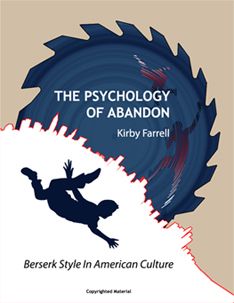
Humans have been tattooing skin, filing teeth, and festooned with ornaments since prehistoric times: sometimes to stand out, sometimes to blend into a group. The 5000+ year old Ice Man (Oetzi) uncovered in the Alps has tattoos that may have telegraphed identity or magical thinking, or worked to relieve, physically or psychosomatically, his local aches and pains. Or all of these.
Today, tattoos have proliferated. While rationales can be as varied as the designs, all tattoos modify self-esteem as well as bodies. Like cosmetics, tattoos are prosthetic, since like an artificial limb they make up for something felt to be missing or inadequate. We're always devising ways to enhance parts of our bodies, from diets and wigs to a Michael Jackson makeover. Once we're self-aware, there's really no such thing as a wholly "natural" body. We compete with others and ourselves to envision a more perfect us.
As a symbol and a behavior, the tattoo has power. The quest to be better than ordinary is an appetite for more life, more good feeling about yourself and more response from others. The tattoo also promises to stop time. The tattoo implies you're in an eternal present, willing to change your body permanently, not worried that the image will eventually become an embarrassing cliché or a maze of wrinkles on grandma's tired skin.
Tattoos idealize youth and fertility by drawing eyes to youthful skin and often erotic parts of the body. In the process they counter anxiety about aging and death. Nothing beats a butterfly for signaling rebirth. Many symbols, including hearts and ancient Egyptian ankhs, are comforting. And this is no surprise, since terror management experiments in social psychology show that people unconsciously honor the potency of immortality symbols such as the cross and the flag.
But you don't have to believe in the magic of pharaonic goddesses or old glory to enjoy death-avoidance. The decision to submit to the tattoing needle is a modestly painful initiation rite. The design substantiates your choice: makes it physical, touchable, enduring. The commitment can be a kind of conversion experience, a mark of independence from parents and conformity. In opening toward ultimate concerns—self-esteem, fertility, death—the ritual is doing the sort of work religion does.
Like a vaccine, fear of death can stimulate useful defenses such as anxiety that scouts for dangers ahead. But death and anxiety are pretty nebulous, especially when denial fuzzes them out. Hence the urge to confront the threat head on in order to subdue it. By putting a skull on your skin, for instance, you—and everyone who looks at you—honor your control over death. The skull insists you're not afraid, and even "own" death. If you emphasize teeth, as in images of wolfish jaws and fangs, the signal is a threat display that should intimidate potential adversaries and pump up you, the beast's owner, turning nervous system flight into courage and fight.
Once upon a time skulls and fangs were mostly military insignia. Like the jaguar-masked warriors of Aztec Mesoamerica, combat soldiers sometimes cope with fear and rage by identifying with death's heads and ferocious animals. Closer to home the ravenous beast is mascot to sports teams pumped up to "wipe out" opponents. These days you can even spot a petite blonde teenager sporting a ravenous beast on her arm. What gives?
For one thing, that devouring maw is open to swallow more life: more food-energy, but also, as a tattoo, more vital attention. We're social animals. It's how we're built. Remember: the self is an event, not a thing. In the neurochemical conditions of deep sleep, the self disappears. We rely on social behavior—attention—to substantiate us and make us feel real. Exile, solitary confinement, and social death punish by starving the self for attention.
Tattoos promise to make you attractive, as if you have a personal force akin to gravity. Notice me. The more attraction you command, the more attention you get, and the more life you have—as we see in the public's devotion to celebrities and leaders. As the name says, hero-worship, too, has a religious character, and if you're the hero, you're superhuman. The more people you have thinking about you, the more of you there seems to be. In the wisdom of slang, you can be, if not godlike, at least a "bigshot."
The devouring beast tattoo is one way of compelling attention. It's threatening but also appealing as a sign of outsized appetite. Greed for attention—and more life—inspires fear and envy, so one function of groups is to regulate competition for attention. Gangs use tattoos to boost a feeling of unique but shared status and power. When it works, the gang emblem pumps up self-esteem even as it absorbs the individual into the group. Tattoos spotlight the individual but also signify membership in the group of similarly marked folks.
But let's keep that ferocious beast in focus. It speaks to the peculiar conflicts that beset the young. They're hungry for life and yet constantly held in check by rivals and the generation ahead of them—which is also hungry to "make it." American culture celebrates freedom, individualism, and entrepreneurial aggressiveness. But in the current economy, the young earn up to 40% less today than a few decades ago. Aspirations go to bed hungry, scraping by on a dead end job and food stamps. Marriage, a house, retirement—these look increasingly chimerical. If you don't have "enough to live on," well, you're dying. The tattoo suggests living for the present rather than emulating the traditional dream.
In today's economy the big fish swallow the little ones. The rich consume the energy of the working poor, and especially the underpaid young. It's like a fairy tale inasmuch as the nation fibs and finesses the reality. In a culture of employment sharks, the ferocious beast tattoo works as a guard dog protecting morale. If the workaday world opens its jaws, the beast tattoo threatens to bite back.
The air is full of biting terrors—literally, if you recall the summer flick Sharknado, in which a tornado flings monstrous sharks into your backyard. No less startling is Werner Herzog's documentary film Grizzly Man, which recounts how Timothy Treadwell escaped the jaws of workaday life by role-playing the innocent friend of ferocious Alaskan grizzlies, one of whom devoured him and his companion. Or consider the judicial killing of Todd Willingham in Texas because, among other hysterical testimony, a witness regarded his heavy metal skull tattoo as a demonic sign making him capable of murdering his young girls in a house fire.
What's striking about threatening tattoos is how equivocal they are. They're frightening signs of real conflicts, yet also just playful abstractions. They wink and snarl at the same time. They make a passive aggressive protest rather than openly defy injustice and abuse. This may be a logical reaction in an era when people feel haunted by a sense of oppression whose sources are masked and too big to confront. Government surveillance crystallizes unease about invisible systems of control and invasions of privacy—really, of self.
In the real economy, for the young and those not "making a living," corporate machinery and slick media have enabled the rich to undermine organized labor, minimum wage and health care initiatives, and lately even the foodstamps that make peonage survivable. In this way the tattooed beast of youth growls at the unseen masters that feed it but keep a tight choke on the collar.
Resources:
Ernest Becker, Escape from Evil
Elias Canetti, Crowds and Power
Jerff Greenberg et al, "The Causes and Consequences of a Need for Self-Esteem: A Terror Management Theory," in R. F. Baumeister (ed.), Public Self and Private Self
"A Terror Management Theory of Social Behavior: the Psychological Functions of self-Esteem and Cultural Worldviews," in Advances in Experimental Social Psychology, Vol. 24.
And now available: from Leveller’s Press and on Amazon: https://store.collectivecopies.com/store/show/Lev%20018(link is external)
THE PSYCHOLOGY OF ABANDON explores letting go as a behavior and a fantasy about behavior. Abandon terrifies but also fascinates us with the possibility of getting access to hidden resources by throwing off inhibitions. Farrell investigates how the idea of running amok lurks as a style in movies, sex, gambing, sports, war, banking and religion.

“This book amazes me with its audacity, its clarity, and its scope. We usually think of ‘berserk’ behaviors—from apocalyptic rampage killings to ecstatic revels like Burning Man—as extremes of experience, outside ordinary lives. in fascinating detail, Farrell shows how contemporary culture has re-framed many varieties of abandon into self-conscious strategies of sense-making and control. Abandon has become a common lens for organizing modern experience and an often troubling resource for mobilizing and rationalizing cultural and political action.This landmark analysis both enlightens and empowers us.”
—Les Gasser, Professor of Information and Computer Science, U. of Illinois,



